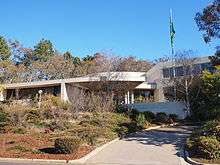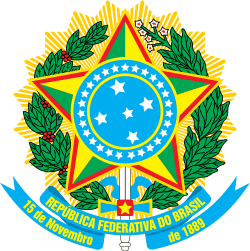Australia–Brazil relations
Australia–Brazil relations refers to the current and historical relations between the Commonwealth of Australia and the Federative Republic of Brazil. Both nations are members of the Cairns Group, G20 and the United Nations. Australia and Brazil are the largest countries in the Southern Hemisphere.
 | |
Australia |
Brazil |
|---|---|
History
Diplomatic relations between Australia and Brazil were established in 1945.[1] The following year, Australia opened a diplomatic office in Rio de Janeiro, its first diplomatic representation in Latin America.[1] That same year, Brazil opened a diplomatic office in Canberra. In 1990, both nations created the Brazil-Australia Political Consultations mechanism, which gave a new impetus to bilateral relations.
In June 2012, Australian Prime Minister, Julia Gillard, paid an official visit to Brazil and met with President Dilma Rousseff.[2] Both leaders discussed deepening of the ties and growth of the role played by the two countries in the world, and they agreed to increase relations between Australia and Brazil at the level of strategic partnership. In November 2014, Brazilian President Dilma Rousseff paid a visit to Australia to attend the G20 Brisbane summit.
Brazil is currently the largest source of international students in Australia outside of Asia and fifth largest globally. There are more than 110 active agreements between Australian education institutions and Brazilian governments and institutions.[3] Through the Direct Aid Program, the Australian Government provides financial support to a range of projects in Brazil. In 2017-18, the Direct Aid Program supported projects across the following focus areas: economic empowerment, minority and gender issues, sports, arts and culture for development.[3]
High-level visits

High-level visits from Australia to Brazil
- Foreign Minister Alexander Downer (2001, 2006)
- Trade Minister Mark Vaile (2004)
- Foreign Minister Kevin Rudd (2010)
- Prime Minister Julia Gillard (2012)
- Foreign Minister Julie Bishop (2015)
- Governor General Peter Cosgrove (2016)
High-level visits from Brazil to Australia
- Foreign Minister Celso Amorim (1994, 2008)
- Special Envoy Marco Aurélio Garcia (2006)
- President Dilma Rousseff (2014)
Bilateral agreements
Both nations have signed several agreements such as a Trade Agreement (1978); Extradition Treaty (1994); Memorandum of Understanding in Health Cooperation (1998); Air Service Agreement (2010); Memorandum of Understanding on Cooperation on Major Sporting Events (2010); Agreement on Science, Technology and Innovation (2017); and a Memorandum of Understanding on Water Cooperation (2018).[4][3]
Trade
In 2018, trade between Australia and Brazil totaled US$1.5 billion dollars.[1] Australia's main exports to Brazil include: coal; crude petroleum; nickel ores and concentrates; and aluminium. Brazil's main exports to Australia include: medicine; coffee; civil engineering equipment and parts; and personal travel services.[3] Brazil is Australia's largest export market in Latin America by a significant margin, including in tourism, travel and education-related services, and accounts for half Australia's direct investment in the region.[3]
Resident diplomatic missions


